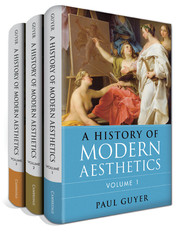Book contents
- Volume 1 The Eighteenth Century
- Volume 2 The Nineteenth Century
- Volume 3 The Twentieth Century
- Frontmatter
- Contents
- Acknowledgments
- Introduction
- Part One German Aesthetics in the Twentieth Century
- Part Two Aesthetics in Britain until World War II
- Part Three American Aesthetics in the First Half of the Twentieth Century
- Part Four Wittgenstein and After
- 11 Wittgenstein
- 12 The First Wave
- 13 The Second Wave
- Epilogue Truth, Feeling, and Play in Recent Aesthetics
- Bibliography
- References
13 - The Second Wave
from Part Four - Wittgenstein and After
Published online by Cambridge University Press: 05 June 2015
- Volume 1 The Eighteenth Century
- Volume 2 The Nineteenth Century
- Volume 3 The Twentieth Century
- Frontmatter
- Contents
- Acknowledgments
- Introduction
- Part One German Aesthetics in the Twentieth Century
- Part Two Aesthetics in Britain until World War II
- Part Three American Aesthetics in the First Half of the Twentieth Century
- Part Four Wittgenstein and After
- 11 Wittgenstein
- 12 The First Wave
- 13 The Second Wave
- Epilogue Truth, Feeling, and Play in Recent Aesthetics
- Bibliography
- References
Summary
In this chapter, we turn to a number of philosophers more influenced by the second part of Wittgenstein’s Philosophical Investigations than by the first: Frank Sibley, Richard Wollheim, Roger Scruton, and Stanley Cavell. Particularly in the case of the last three, the return to a more comprehensive approach to aesthetic experience seems to have been more intentional than accidental, as almost seems to have been the case with Danto. Wollheim and Cavell in particular offer models for the threefold synthesis of the aesthetics of truth, feeling, and play in the late twentieth century.
Sibley
Let us begin with another aspect of Wittgenstein’s influence in the 1950s, the debate over whether “aesthetic concepts” are “condition governed” or rule-governed that was initiated by Frank Sibley (1923–96) in 1959. A student of Gilbert Ryle at Oxford who taught at Wittgenstein-dominated Cornell before taking up a professorship at the University of Lancaster, Sibley wrote a paper, “Aesthetic Concepts,” and several subsequent papers that actually criticized the family-resemblance approach to aesthetic concepts as still too close to the traditional paradigm according to which concepts have necessary and sufficient conditions for their application and argued instead that the use of aesthetic concepts can be objective and based on perceptible properties in objects without being governed by rules at all. In the Wittgensteinian mode, Sibley identified “aesthetic” or “taste” concepts not with a narrow list of overall evaluative predicates such as “beautiful” or “ugly,” but instead with open-ended lists such as “unified, balanced, integrated, lifeless, serene, somber, dynamic, powerful, vivid, delicate, moving, trite, sentimental, tragic,” and added that “the list of course is not limited to adjectives,” because aesthetic concepts are also conveyed in terms such as “telling contrast, sets up a tension, conveys a sense of, or holds it together.”
- Type
- Chapter
- Information
- A History of Modern Aesthetics , pp. 499 - 556Publisher: Cambridge University PressPrint publication year: 2014



